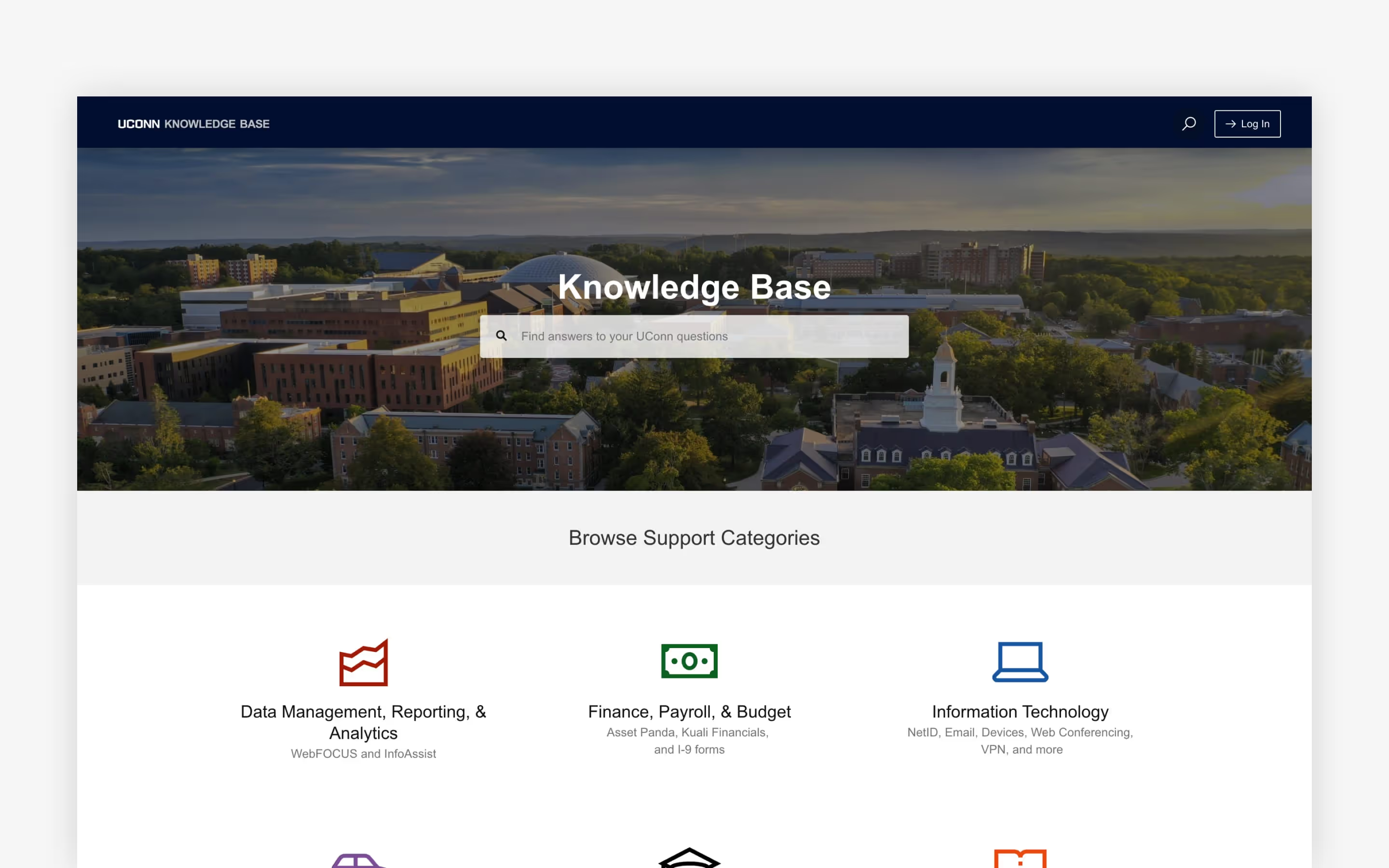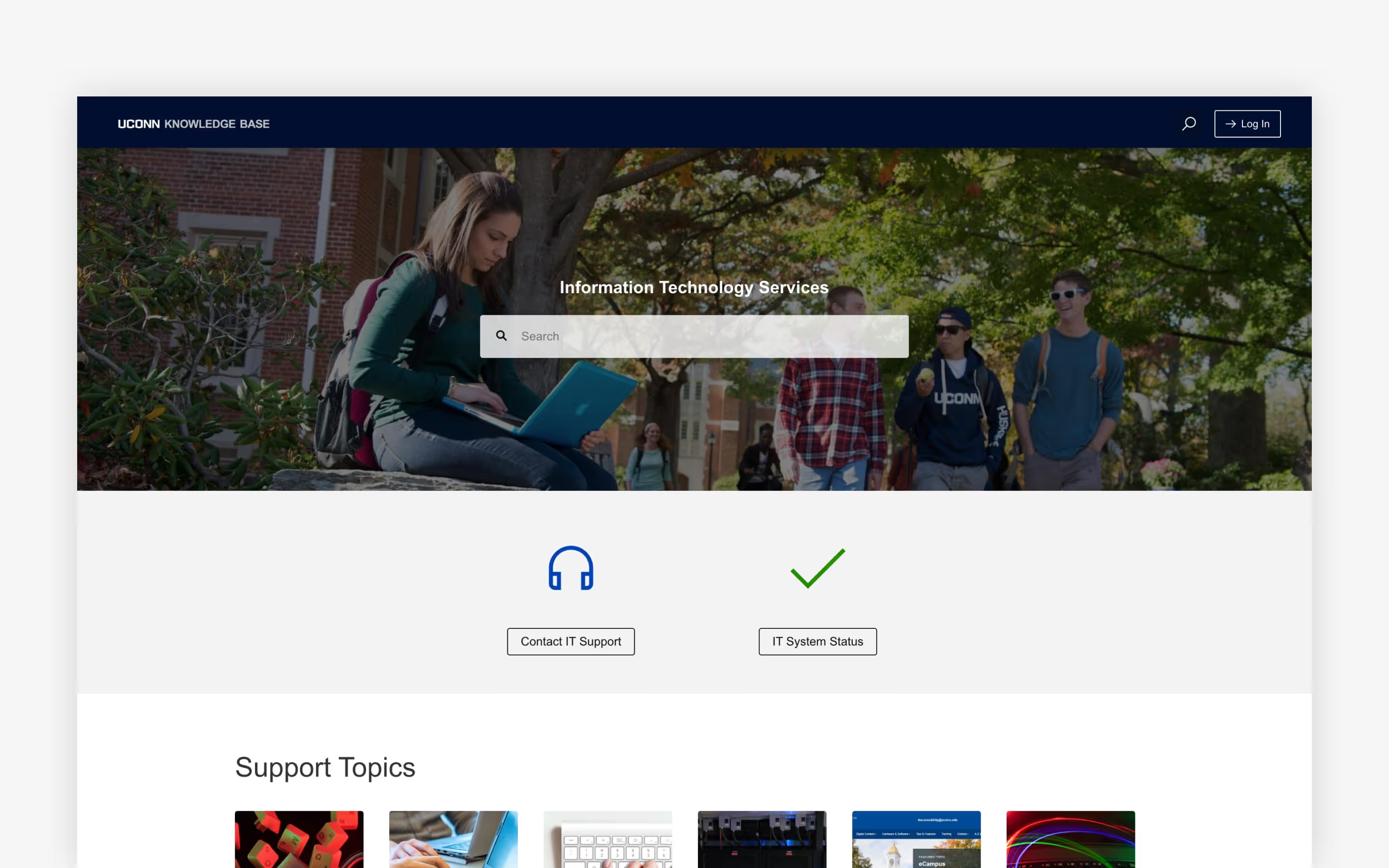UConn's knowledge base sees upwards of 30,000 visitors per month—sometimes double during busy periods—and has been a conduit for more than 130,000 support requests in the last three years alone.
Confluence proved to be a robust content-creation tool, but the interface wasn’t ideal for the casual visitor who needed a quick pathway to information or an easy route to file a support request.
One of UConn’s main objectives was to make searches more effective and allow greater flexibility and participation among the large base of content contributors. So far, it's working.
With a main campus in Storrs, Connecticut, and six other campuses around the state, the University of Connecticut (UConn) is one of the top public research universities in the United States. More than 32,000 students attend classes across UConn’s network, which includes a law school and medical school in addition to a range of undergraduate and graduate programs. With a $3 billion annual budget and more than 8,500 full- and part-time employees, the University is also a major economic engine.
About UConn
Not surprisingly, UConn’s vast scale necessitates a comprehensive web of IT resources to power everyday campus life for faculty, staff, and students. Holding it all together is the University’s Information Technology Services (ITS) department, a 180-person team providing services that support research, teaching, learning, and outreach.
What’s their secret? A knowledge base — kb.uconn.edu — with integrated support powered by Confluence, Jira Service Management and Refined Sites. The cloud site, managed in true wiki fashion by some 700 employees with edit rights, houses documentation for eight subject areas, each tied to its own JSM service organization. Among them: Student Academics & Services, Teaching & Learning, Data Management, Reporting & Analytics, and more.
The site regularly sees upwards of 30,000 visitors per month—sometimes double during busy periods—and has been a conduit for more than 130,000 support requests in the last three years alone.
From FAQs to Confluence to Refined Sites
Today UConn’s knowledge base is housed in Confluence and Refined Sites, but as recently as a few years ago it didn’t exist. In fact, the state-of-the-art interface represents a years-long effort to modernize and streamline the way knowledge and support are managed, stored and delivered to end customers at the university.
Previously, ITS maintained an extensive FAQ on their site and several departments had their own mini knowledge bases, mostly powered by WordPress. But due to the surge in remote support requests during the pandemic in 2020, the team found themselves in need of an upgrade.
Creating a centralized repository of knowledge would increase the speed and efficiency with which users could find the information and solutions they need, the thinking went, perhaps driving down support requests and, hopefully, delivering a more-modern user experience in the process.
“What we had previously was never meant to be a searchable knowledge base, so we basically started from scratch,” explains Ashley Mattingly, ITS Communications Administrator. The team selected Confluence because they wanted it to integrate with a support-ticketing system like JSM from the get-go.
Confluence proved to be a robust content-creation and management tool, but the interface left something to be desired. It wasn’t ideal for the casual visitor who needed a quick pathway to information or to file a request.
They also needed a way to make sure their site was intuitive to three distinct sets of visitors they were serving: students, faculty and staff.

We really embrace the Wiki [approach]. [We want] to give people more control over their material — to post it, edit it, and grow it freely.
No more “I can’t find this article”
One of ITS’ main objectives going into the knowledge base project was to make searches more effective and allow greater flexibility and participation among the large base of content contributors.
“We really embrace the Wiki [approach]. [We want] to give people more control over their material — to post it, edit it, and grow it freely,” says Mattingly. The team was determined to use tools that would align with this philosophy.
Changes to the site structure have resulted in vastly improved search results with fewer complaints of “I can’t find this.”
The flexibility to build multiple Refined sites from a single Confluence instance has also allowed for a more personalized experience across departments. While the main knowledge base is the central hub, there are a few offshoots. The College Of Liberal Arts And Sciences and the Student Affairs Information Technology department, for example, both have their own sites.
A user-centric design
UConn’s Refined sites sport a theme that aligns with the university’s branding, including UConn’s logo and colors. Still, Web Designer Christopher Cerrigione allows the departments operating their own sites the flexibility to make design and layout choices that achieve their specific needs.
Clean and simple is always the main design objective. Take kb.uconn.edu. “We chose to go with eight buckets on the main page for a streamlined, unified look,” Cerrigione says.
User-centricity was also top of mind during the design phase.
“A lot of what you see on [the knowledge base] is what we think would resonate the most with our end user, with our community. And so that's why it's separated by topics and not so much by our internal organization at the university,” Mattingly explains. “One example is our financial material. We have stuff in the comptroller's office and we have stuff from payroll, but for our end user, they're just going to think of it as the ‘financial information’ so it made sense to organize it that way.”
Catalyzing organizational change
It wasn’t an easy cultural shift to get everyone in the university community on board with the new knowledge base, but in the end, users found they were getting value from the new tool and came on board.
More recently the ITS team decided to make the switch to a cloud-based Atlassian instance. “Cloud is where new functionality is occurring most frequently,” says Will Harris, UConn’s administrator for Confluence and Jira. “And we want to be on the cutting-edge.”
We chose to go with eight buckets on the main page for a streamlined, unified look.
– Christopher Cerrigione, Web Designer, ITS
More stories
Try Refined free for 30 days


































